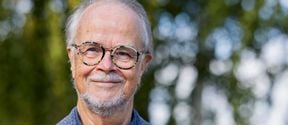TMS revealed differences between brain activity of people who dream and people who do not dream
Dr. Gosseries and Dr. Nieminen are preparing a subject (Bjørn Erik Juel) for the experiment. Photo: Johan Frederik Storm
Researchers from Aalto University and the University of Wisconsin utilised a TMS-EEG device, which combines transcranial magnetic stimulation and EEG, to examine how the brain activity of people in the restful non-rapid eye movement (NREM) sleep is affected by whether they dream or do not dream.
When the NREM sleep of subjects had lasted at least three minutes, researchers gave magnetic pulses that induced a weak electric field and activated neurons. After a series of pulses, the subject was woken with an alarm sound, and they were then asked whether they had dreamed and to describe the content of the dream.
'It is traditionally thought that dreaming occurs only in REM sleep. However, as also our study demonstrates, subjects woken from NREM sleep are also able to give accounts of their dreams in more than half of cases,' Post-doctoral Researcher Jaakko Nieminen from Aalto University explains.
'EEG showed that the deterministic brain activity produced by magnetic pulses was notably shorter in people who did not dream, i.e. were unconscious, than in people who had dreamt. We also observed that the longer the story about the dream, the more the subject's EEG resembled that measured from people who were awake,' Dr Nieminen explains.
Assessment of consciousness may help in treatment of brain injury patients.
Dr Nieminen performed the measurements with his research colleague Olivia Gosseries at the University of Wisconsin–Madison Center for Sleep and Consciousness, which is headed by Giulio Tononi one of the world's most renowned researchers of consciousness. The measurements were carried out during a period of over 40 nights and a total of 11 subjects participated. Due to sleeping difficulties and other challenges, reliable measurements could only be acquired from six subjects. During the night, subjects were woken a maximum of 16 times.
EEG responses evoked by transcranial magnetic stimulation during NREM sleep when subjects dreamt (red line) and did not dream (blue line). When subjects did not dream, 200 milliseconds after the stimulation, a strong deflection was visible in their EEG. This type of response is typical of cortical networks that are in a so-called bistable state in which after initial activation their activity resumes stochastically. The black and grey lines show statistically significant differences between the conditions. The responses visible on the right have been averaged over the channels specified with dashed lines.
'Consciousness in different physiological states (e.g. during wakefulness, sleep, anesthesia and vegetative state) has previously been researched with TMS–EEG measurements. We wanted to eliminate all other differences related to the different states as thoroughly as possible, and for this reason we focused on the narrow physiological state of NREM sleep,' Dr Nieminen notes.
Transcranial magnetic stimulation is already utilised in such things as the treatment of depression and pain. According to Dr Nieminen, in the future the precise data provided by TMS–EEG measurements on the state of consciousness may also help e.g. in the treatment of those brain injury patients who are unable to communicate.
Article: Jaakko O. Nieminen, Olivia Gosseries, Marcello Massimini, Elyana Saad, Andrew D. Sheldon, Melanie Boly, Francesca Siclari, Bradley R. Postle, Giulio Tononi: Consciousness and cortical responsiveness: a within-state study during non-rapid eye movement sleep. Scientific Reports 6, 30932 (2016).
Link: http://www.nature.com/articles/srep30932
More information:
Post-doctoral Researcher Jaakko Nieminen
Aalto University Department of Neuroscience and Biomedical Engineering
Tel. +358 50 344 3186
[email protected]
- Published:
- Updated:
Read more news

Aalto ARTS alum Vidha Samya’s artwork featured at the Venice Biennale 2024
The Pavilion of Finland presents ‘The pleasures we choose’ at the 60th International Art Exhibition – La Biennale di Venezia until 24 November 2024.
IoT Forge donates EUR 1 million to the School of Engineering
The donation will be used for research and education on the Industrial Internet and digital twins.
Join us for the first Aalto Open Science Award Ceremony
All Aaltonians are welcome – no registration required!